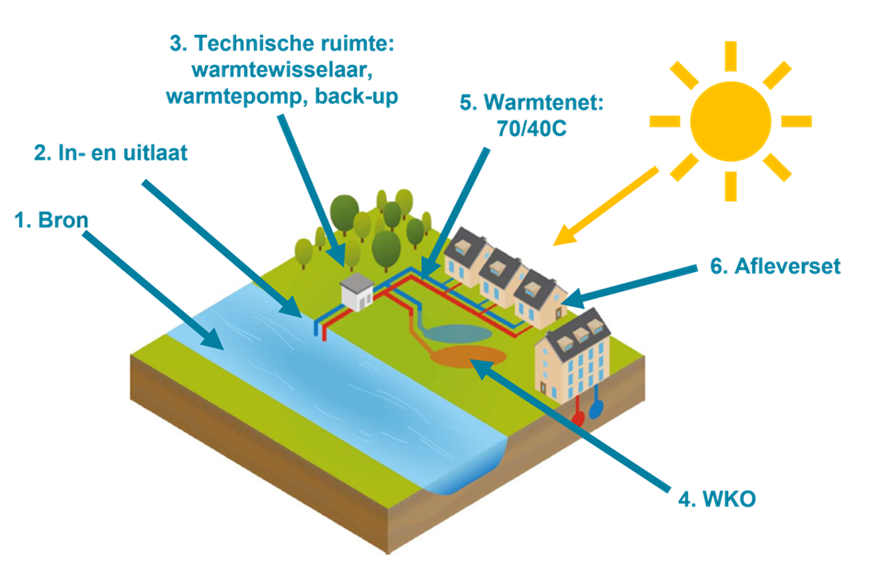Aquathermy
Aquathermy is the collective term for sustainable heating and cooling with water. It involves Thermal Energy from Surface Water (TEO) or from Wastewater (TEA). We use the heat from surface water or wastewater and let colder water flow back into the water system or sewage system.
Aquathermy is increasingly seen as a sustainable alternative to natural gas. The technology is increasingly in the spotlight. As a water manager, HHNK is keen to encourage aquathermy projects using heat from surface and wastewater.
TEO makes it possible to utilize heat or cold from ponds and water. TEA uses heat from sewers, sewage pumping stations, pressure pipes and sewage treatment plants. In both cases, renewable heat and/or cold is extracted from water.
How does aquathermy work?
Heat is extracted from water with a heat exchanger. The heat is upgraded with a heat pump to a usable temperature for heating homes and buildings. This can be done with a collective or individual heat pump that requires electricity. Heat is transported via a heat network.
TEO is often combined with heat and cold storage (CHP). For example, hot water is stored in the summer for use in the winter. During this period, the surface water temperature is too low for heat extraction. An additional advantage of an ATES is that in addition to heating, a home can also be cooled. With TEA, water temperatures remain relatively high in the winter, so application of an ATES is not always necessary.

Advantages
Aquathermy has several advantages. Starting with the energy balance. Aquathermy produces four times as much energy as it takes to extract the heat. So that's how you "earn" energy.
In addition to the energy balance, aquathermy also has water quality benefits. With this technique, dead-end ditches can not only become flowing, but also cooler. It also introduces more oxygen into the water, reducing the incidence of blue-green algae. Cooling of surface water in the summer also benefits water quality in a general sense. Finally, aquathermy is also very easy to incorporate spatially.
This explains the increasing popularity of this heat source among municipalities, project developers, energy cooperatives and water boards. Because of the positive effects on water quality and the general social interest, HHNK therefore actively supports aquathermy initiatives with knowledge and advice.
How can HHNK help you?
We have developed a viewer that allows you to discover for yourself how much heat can be extracted from water in your neighborhood. In addition, we advise municipalities on aquathermy in the heat transition. Project developers and energy cooperatives can also contact us for tailored advice and support. We regularly make a targeted quick scan for a neighborhood or a new construction site.
It is also important to know what the consequences of aquathermy are for aquatic life. Due to the relative newness of the technique, not everything is known about this yet. We are therefore conducting research into the effects of aquathermy on water quality and ecology.
Viewer
HHNK developed this viewer together with the province of North Holland, the Water Board AGV and the Rhineland Water Board. Because of this cooperation, the viewer contains an enormous amount of information relevant to the application of aquathermy. For example, HHNK provided data on the water system and wastewater. In addition, the province has information on building years, energy labels, new construction plans and housing densities, among other things. Finally, the viewer contains an analysis tool that shows whether sufficient heat from water is available for a selected location.
Sample projects
- HHNK recently participated in the development of the Zaanse Helden in Zaandam. This apartment complex will be heated entirely on aquathermy from the Zaan.
- Aquathermy is also now being installed in the Holenkwartier in Hoorn.
Learn more
For frequently asked questions and more substantive information on aquathermy, please refer to the Aquathermy Network website .
Want to learn more about aquathermy? Then watch this video from our colleagues at Waternet.